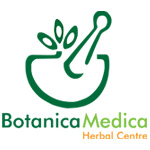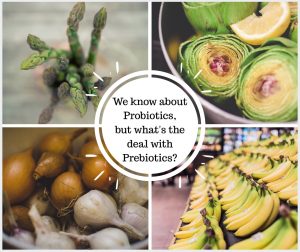We Know About Probiotics, But What’s The Deal With Prebiotics?
Chances are you eat many of these foods every day.
At Botanica Medica we often talk about probiotics and prebiotics, although a lot of us know what probiotics are, do we understand prebiotics and what role they play in our gut health. This is a great article from HuffPost Australia that explains the difference between probiotics and prebiotics and what we can eat to improve our levels of both, and in turn help lower inflammation and disease risk.
Probiotics have become an incredibly popular and important topic in recent years, as they can play a role in many facets of health and wellness, from regulating inflammation to promoting mental health.
We can find probiotics in a range of readily available (and delicious) foods, like yoghurt, sauerkraut and kombucha — but what about probiotics’ lesser known sister?
Let’s talk about prebiotics.
“While many of the food ingredients we consume are digested immediately, prebiotics are a type of non-digestible fibre compound in the form of food or supplement,” dietitian Robbie Clark told HuffPost Australia.
“Similar to other high fibre foods, prebiotic compounds pass through the upper part of the gastrointestinal tract and remain undigested, since the human body can’t fully break them down. Once they pass through the small intestine, they reach the colon, where they’re fermented by the gut microflora. This process improves digestion by increasing the level of probiotics in the gut.”
The most simple way to describe prebiotics is they are the food for the healthy bacteria found in our gut.
“Probiotics are the actual bacteria, so the prebiotics are what provide the food that help keep the probiotic healthy, which in turn helps keep our gastrointestinal tract healthy,” accredited practising dietitian and sports dietitian, Chloe McLeod, told HuffPost Australia.
“A lot of the time prebiotic foods will be broken down into what is called short chain fatty acids, and then they get used up by the bacteria as an energy source.”
“In a nutshell, prebiotics help feed or fertilise the friendly bacteria (probiotics) and act as their food source to help grow more beneficial bacteria in the gut, having favourable effects on the intestinal flora,” Clark added.
Because the health of our gut is closely linked to many other bodily functions, prebiotics and probiotics together are important for fighting inflammation and lowering overall disease risk.
Probiotics, on the other hand, are live micro-organisms contained in the food we eat or in the form of supplementation.
“They remain intact throughout the digestive process and deliver healthy bacteria directly to the large intestine,” Clark explained. “Probiotics do not stimulate metabolic activity and, therefore, provide a different set of benefits than prebiotics. Both prebiotics and probiotics are valuable for our health and wellness, and can act symbiotically to provide numerous health benefits.”
Prebiotic compounds are found in an array of everyday foods, and can be incorporated into your diet very easily.
“Some great examples of prebiotic foods are legumes (like chickpeas, lentils and kidney beans), whole grains (barley, rice, quinoa), onion and garlic, asparagus and just ripe bananas (still yellow),” McLeod said.
If you love hummus, you’ll be happy to know that the chickpea and garlic dip is a prebiotic powerhouse.
Here are some easy ways to cook with prebiotic foods:
Garlic — Include in homemade salad dressings, marinades, guacamole, dips, spreads and hummus, stir frys, risotto, pasta dishes, roasts and soups.
Jerusalem artichokes — Include in dips, antipasto plates, salads, soups, roasts, mash and casseroles.
Asparagus — Include in salads, risotto, pie filling, pasta dishes, soups, omelettes and scrambled eggs.
Leeks — Include in risotto, soups, casseroles and bakes.
Unripe banana — Include in smoothies and homemade baking. For example, muffins, bread and desserts.
Dandelion greens — Eat them raw by chopping them finely and adding them to a salad or side dish.
Onions — Best used in savoury dishes and condiments such as sauces, salads, soups, casseroles, pasta dishes, risotto, stir frys or grilled on the barbecue.
Legumes — Add to stews, pasta sauce, Mexican dishes, salads and stir frys, or blend chickpeas with garlic, tahini and olive oil to make hummus.
Whole grains — Include in soups, stews, curries, stir frys and salads.
Make a delicious loaf of banana bread.
According to Clark, not consuming enough prebiotics and probiotics can compromise gut health, which has a flow-on effect on other systems in the body.
“Because the health of our gut is closely linked to many other bodily functions, prebiotics and probiotics together are important for fighting inflammation and lowering overall disease risk,” Clark said.
“Higher intakes of prebiotics are linked to many health benefits,” Clark said.
These include:
* Lower risk for cardiovascular disease
* Healthier cholesterol levels
* Better overall gut health
* Improved digestion
* Lower stress response
* Better hormonal balance
* Improved mental health
* Higher immune function
* Lower risk for obesity and weight gain
* Lower inflammation and autoimmune reactions
“This is a really interesting area of research, and one that requires more research, but what’s been shown so far is that if you don’t have a nice mix of these [prebiotic] foods, it can potentially change your gastrointestinal flora, or change which types of probiotics are present in your gut,” McLeod said.
With many people following diets such as low FODMAP, or restrictive fad diets which exclude prebiotic foods, it’s important to know that these diets should not be followed long term.
“As an example, a lot of the prebiotics foods are actually also really high FODMAP. Some of the research is starting to show that long term avoidance of particular prebiotic foods can then change that mix of bacteria. That’s why, if you start a low FODMAP diet, it’s really important to not stay being low FODMAP long term.”
At Botanica Medica our Naturopaths are well aware of the importance of a good diet and the effect it can have on your life both physically and mentally. They come across lots of interesting articles and are always updating their knowledge. If you would like to make an appointment with one of our Naturopaths call Botanica Medica on 8271-1827 today. They are only to happy to share the knowledge they have gained through their studies and patient outcomes, and get you feeling better. Botanica Medica is located at 97 Glen Osmond Road, Eastwood and appointments are available Monday to Saturday including some after hours.
08/11/2016 10:26 AM AEDT | Updated 08/11/2016 3:07 PM AEDT
* Juliette Steen
Associate Food Editor, HuffPost Australia


Recent Comments